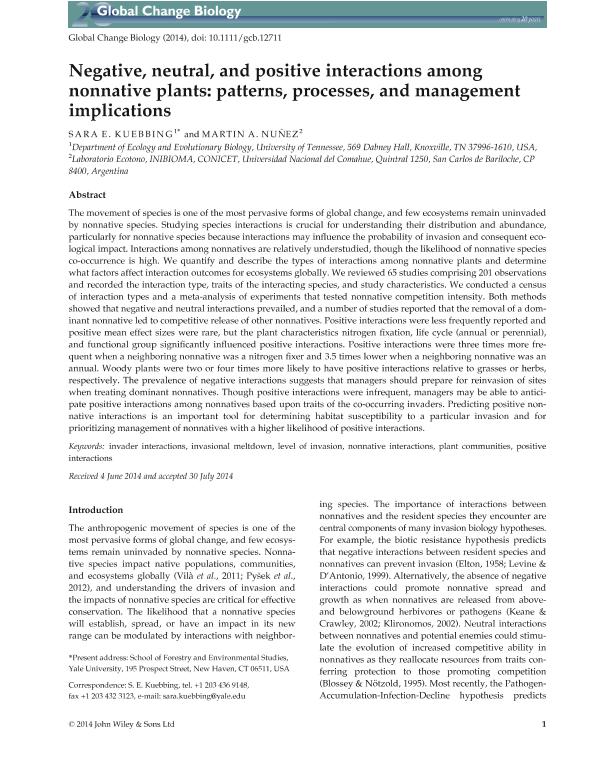Mostrar el registro sencillo del ítem
dc.contributor.author
Kuebbing, Sara E.
dc.contributor.author
Nuñez, Martin Andres

dc.date.available
2017-01-26T20:53:24Z
dc.date.issued
2015-02
dc.identifier.citation
Kuebbing, Sara E.; Nuñez, Martin Andres; Negative, neutral, and positive interactions among nonnative plants: patterns, processes, and management implications; Wiley; Global Change Biology; 21; 2; 2-2015; 926–934
dc.identifier.uri
http://hdl.handle.net/11336/12046
dc.description.abstract
The movement of species is one of the most pervasive forms of global change, and few ecosystems remain uninvaded by nonnative species. Studying species interactions is crucial for understanding their distribution and abundance, particularly for nonnative species because interactions may influence the probability of invasion and consequent ecological impact. Interactions among nonnatives are relatively understudied, though the likelihood of nonnative species co-occurrence is high. We quantify and describe the types of interactions among nonnative plants and determine what factors affect interaction outcomes for ecosystems globally. We reviewed 65 studies comprising 201 observations and recorded the interaction type, traits of the interacting species, and study characteristics. We conducted a census of interaction types and a meta-analysis of experiments that tested nonnative competition intensity. Both methods showed that negative and neutral interactions prevailed, and a number of studies reported that the removal of a dominant nonnative led to competitive release of other nonnatives. Positive interactions were less frequently reported and positive mean effect sizes were rare, but the plant characteristics nitrogen fixation, life cycle (annual or perennial), and functional group significantly influenced positive interactions. Positive interactions were three times more frequent when a neighboring nonnative was a nitrogen fixer and 3.5 times lower when a neighboring nonnative was an annual. Woody plants were two or four times more likely to have positive interactions relative to grasses or herbs, respectively. The prevalence of negative interactions suggests that managers should prepare for reinvasion of sites when treating dominant nonnatives. Though positive interactions were infrequent, managers may be able to anticipate positive interactions among nonnatives based upon traits of the co-occurring invaders. Predicting positive nonnative interactions is an important tool for determining habitat susceptibility to a particular invasion and for prioritizing management of nonnatives with a higher likelihood of positive interactions.
dc.format
application/pdf
dc.language.iso
eng
dc.publisher
Wiley

dc.rights
info:eu-repo/semantics/openAccess
dc.rights.uri
https://creativecommons.org/licenses/by-nc-sa/2.5/ar/
dc.subject
Invader Interactions
dc.subject
Invasional Meltdown
dc.subject
Level of Invasion
dc.subject
Nonnative Interactions
dc.subject
Nonnative Interactions
dc.subject
Plant Communities
dc.subject
Positive Interactions
dc.subject.classification
Ecología

dc.subject.classification
Ciencias Biológicas

dc.subject.classification
CIENCIAS NATURALES Y EXACTAS

dc.title
Negative, neutral, and positive interactions among nonnative plants: patterns, processes, and management implications
dc.type
info:eu-repo/semantics/article
dc.type
info:ar-repo/semantics/artículo
dc.type
info:eu-repo/semantics/publishedVersion
dc.date.updated
2016-12-12T14:22:43Z
dc.identifier.eissn
1365-2486
dc.journal.volume
21
dc.journal.number
2
dc.journal.pagination
926–934
dc.journal.pais
Estados Unidos

dc.journal.ciudad
Hoboken
dc.description.fil
Fil: Kuebbing, Sara E.. University Of Tennessee; Estados Unidos
dc.description.fil
Fil: Nuñez, Martin Andres. Universidad Nacional del Comahue. Centro Regional Universitario Bariloche. Laboratorio de Ecotono; Argentina. Consejo Nacional de Investigaciones Científicas y Técnicas. Centro Científico Tecnológico Patagonia Norte. Instituto de Investigación en Biodiversidad y Medioambiente; Argentina
dc.journal.title
Global Change Biology

dc.relation.alternativeid
info:eu-repo/semantics/altIdentifier/doi/http://dx.doi.org/10.1111/gcb.12711
dc.relation.alternativeid
info:eu-repo/semantics/altIdentifier/url/http://onlinelibrary.wiley.com/doi/10.1111/gcb.12711/abstract
Archivos asociados
